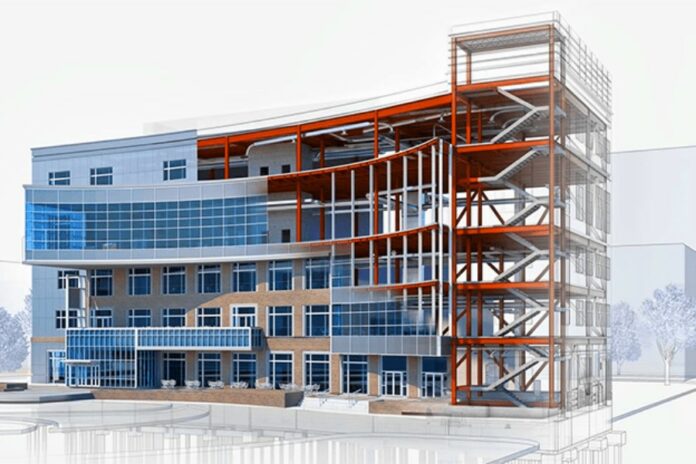Computer-Aided Design [CAD] is a software used by structural engineers, architects, contractors and project managers to create precise drawings and illustrations of new buildings or project plans. It can be either two-dimensional or three-dimensional. It pinpoints accurate measurements, spots design flaws, and conducts advanced analysis on designs. All computer-aided design software will have X (horizontal), Y (vertical), and Z (depth) coordinates. Using these coordinates, allows users to create two – or three -dimensional models, depending on the requirement.
Advantages of Computer-Aided Design [CAD] in construction
It offers several advantages for contractors, structural engineers, architects and project managers, each of them are given below.
- The primary advantage of computer-aided design software is the degree of accuracy and precision able to be achieved for technical drawings.
- For customised programs, there are many convenient CAD automation tools available to easily modify and alter existing drawings for quick modification.
- It helps contractors by storing the drawings and plans in the cloud. This allows contractors to use their plans at any location. Also, if they are included in a shared file for the project, they can easily see changes to the plans.
- It enables project managers to visualize the building and all the parts that go into it, from the steel beams to the tiniest of screws. This puts an incredibly accurate blueprint of the building at your fingertips, allowing you the flexibility to make change decisions of designs.
- Construction structural engineers can make more accurate representations and modify them easily to improve design quality.
- The software enables architects a model overview of electricity, plumbing, and other elements, helping to create a more comprehensive design. Ultimately, this translates to fewer work changes and fewer surprises during construction.
- It uses the design objectives and parameters entered, such as material, construction or manufacturing method and costs, and the computing power of the cloud. Based on the objectives and parameters, the cloud computing power generates several design options.
- When the design for a proposed building, road or bridge is created on a CAD platform, the visualizations that the technology provides makes it easier for earthworks crews to foresee how the finished structure will look from the ground up.
- It makes it possible for structural engineers to generate maps and analyze specs across a stretch of land. This research enables better-informed designs for railways and tunnels, thus reducing potential errors and costly redrafts down the line.
- The software allows conceptualists to take a raw idea and turn it into a three-dimensional design. This allows different branches of a development team to mutually review a proposed design idea and make suggestions that can easily be implemented.
- CAD lets you access your plans from the cloud, so you can pull it up in an instant on your mobile phone if you wanted to.

Different Types of Computer-Aided Design [CAD] in construction
There are two different distinctions among the types of CAD software used in the construction industry.
2D / 3D CAD for technical drawings and drafting
Technical drawings using 2D/3D CAD software give you the exact shape, dimensions and composition of an object with a view to its fabrication. There are two types of drawings. The first is a drawing done without instruments, known as a sketch. The second is a drawing done with instruments, known as a final drawing.
There are many types of technical drawings, including:
- 3D drawings (isometric, perspective)
- Exploded-view 3D drawings
- Complete working drawings
- Detail drawings (2D orthogonal projections)
Once the design is ready the drafters use computer-aided design (CAD) software to develop floor plans, building permit drawings, building inspection plans and landscaping layouts.
CAD software for drafting can be used to draft designs more quickly and with greater precision, without using stencils and technical drawing instruments. It also allows users to document and annotate drawings with text, dimensions, leaders and tables. 2D/ 3D technical allows a technical drafter to make revisions in case of errors, which is more reliable compared to manual drawing where the drafter will have to redraw from scratch.
CAD for Solid Modeling
CAD Solid Modeling is considered one of the common practices used by different vendors for outsourcing purposes because of increasing construction costs and making complex structures. The type of software uses new-age tools for modifying, creating, analyzing, and optimizing models of the object or to create animation and special effects of building and projects. Its functions include;
- A complete view of the proposed buildings from different angles with all featured elements, colors, shapes.
- Reviewing all designing elements before the starting of the actual construction process
- Schedule generation and quantity calculation of a project
CAD solid modeling comes in three types, 3D CAD for wireframe, 3D CAD for surface modeling and 3D CAD for solid modeling.
Conclusion
Whether it’s designing complex building structures or creating detailed architectural plans, hiring an AutoCAD Designer with expertise in computer-aided design (CAD) can greatly streamline the construction process. Top platforms like Toptal offer access to highly skilled AutoCAD Designers who can bring precision and efficiency to your construction projects.
Discussed above are the different advantages and different types of CAD used in construction. In upcoming articles we will discuss the complete analysis of advantages it brings for project managers, contractors, architects, structural engineers and also on different CAD design drafting solutions used in construction.

